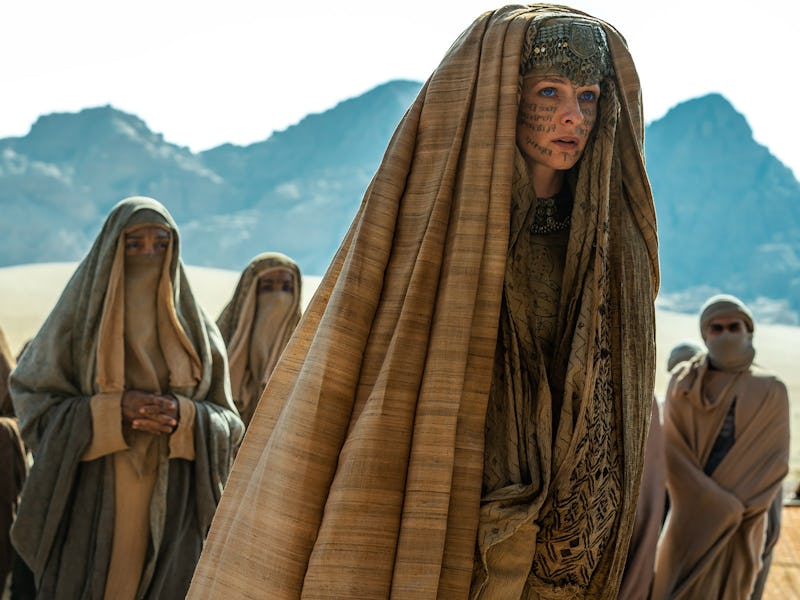Why Dune 2 Had to Change the Bene Gesserit
Denis Villeneuve’s epic sequel puts a fresh emphasis on the cosmic sisterhood.

The main character of Dune might not really be Paul Atreides. In the first book, Lady Jessica emerges as a second protagonist, a counter to Paul’s arc. Now, as Dune: Part Two adapts the rest of that book, audiences will see a greater emphasis on Jessica and the superhuman religious sisterhood of the Bene Gesserit writ large. Their already pivotal role is even more pronounced in Dune: Part Two, and there’s a clear reason why: Director Denis Villeneuve was determined to preserve his favorite part of Dune, even if that meant changing some details of the story.
During a 2023 interview at Brazil’s CCXP convention, Denis Villeneuve pointed out that he de-emphasized the role of the Spacing Guild and human-computer Mentats because he wanted to leave room for the Bene Gesserit’s role to be sufficiently impactful. “In my adaptation, the Mentat suffered... but it’s a declaration of love to the Bene Gesserit,” Villeneuve said.
Speaking to Inverse, Villeneuve reveals that the role of one Mentat in particular, Thufir Hawat (Stephen McKinley Henderson), was greatly reduced to keep the Bene Gesserit in the limelight. “It’s a character that I absolutely love, and I love Stephen Henderson dearly,” Villeneuve says. “I wish I had been able to figure out [that] part of the story... but it was not possible because it’s a movie that becomes quickly complex with the amount of characters. I had to make a difficult choice. It was a difficult decision to make and a very painful one.”
Enter Lady Fenring
Léa Seydoux as Lady Fenring, who’s being elevated from a minor role.
As Hawat’s role was reduced, a minor Bene Gesserit, Lady Fenring, was elevated. In the novel, Lady Fenring is the wife of Count Fenring, but in the film, where she’s played by Léa Seydoux, she’s very much her own character.
“When you adapt, you transform in some ways. It’s a very harsh process where you transform something,” Villeneuve says. “My adaptation of Dune is about the Bene Gesserit. Someone could have made a Dune adaptation about the Mentats or about the Guild Navigators. I focused the adaptation of the first book mainly on the Bene Gesserit sisterhood. And that informs all the choices I’ve made.”
As in the novel, Lady Fenring is a member of the inner circle of Emperor Shaddam IV (Christopher Walken). But as the trailers make clear, she has a mission from the Bene Gesserit sisterhood to seduce Feyd-Rautha (Austin Butler). This plan is never revisited in Frank Herbert’s novels, but the idea is this: the Bene Gesserit are trying to produce a super-being known as the Kwisatz Haderach. Paul appears to fill that role, but one of many backup plans involves a child of Feyd and Lady Fenring.
While this child, Marie Fenring, doesn’t actually appear in any of Frank Herbert’s books, she does show up in the spinoff novel Paul of Dune, written by Kevin J. Anderson and Brian Herbert, Frank Herbert’s son. Because this is such an obscure plot point that Herbert never addressed in subsequent books, no previous film adaptation had bothered including Lady Fenring.
But Villeneuve crafted his Dune around the machinations of the Bene Gesserit. This is why Dune: Part Two also includes a second member of the Bene Gesserit not glimpsed in Part One: Princess Irulan.
The rise of Irulan
Florence Pugh as Princess Irulan.
Dune: Part Two sees the return of Lady Jessica, perhaps the most powerful Bene Gesserit of them all. And as we saw in Part One, Jessica is pregnant with a daughter who’s destined to become Alia, a child born with the nearly infinite memories of all the Bene Gesserit who came before her.
But Dune: Part Two also features the debut of Irulan (Florence Pugh), a member of the Bene Gesserit who’s underestimated by the rest of the sisterhood. Later, Irulan not only outlives Paul and Chani, but becomes the de facto storyteller of the first book. While the first three novels point out that Irulan’s Bene Gesserit powers aren’t as pronounced as Jessica’s or Alia’s, her greatest power — as a history writer — is unmatched. In a sense, she’s one of Dune’s most important characters, even if she may not come across that way.
In Dune: Part One, we saw the Bene Gesserit as veiled sci-fi nuns in witchy black robes. But in Part Two, the ranks of the sisterhood are populated by all different kinds of women. These choices have forced other parts of the book into the background. But if Denis Villeneuve hadn’t made these choices, viewers wouldn’t have felt the profound impact of Frank Herbert’s most unique creation.